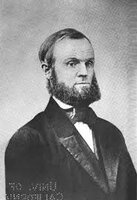Deleted member 16390
The Man from I.N.C.E.L.
-
- Joined
- Dec 25, 2018
- Posts
- 4,795

Oneida Community - Wikipedia
John Humphrey Noyes started his Sex Cult in 1848 in Oneida, New York, when it disbanded, became the Oneida Cutlery/Utensil company.
The Oneida Community was a perfectionist religious communal society founded by John Humphrey Noyes in 1848 in Oneida, New York. The community believed that Jesus had already returned in AD 70, making it possible for them to bring about Jesus's millennial kingdom themselves, and be free of sin and perfect in this world, not just in Heaven (a belief called perfectionism). The Oneida Community practiced communalism (in the sense of communal property and possessions), complex marriage, male sexual continence, and mutual criticism. There were smaller Noyesian communities in Wallingford, Connecticut; Newark, New Jersey; Putney and Cambridge, Vermont.[1] The community's original 87 members grew to 172 by February 1850, 208 by 1852, and 306 by 1878. The branches were closed in 1854 except for the Wallingford branch, which operated until devastated by a tornado in 1878. The Oneida Community dissolved in 1881, and eventually became the silverware company Oneida Limited.[2]
Complex marriage[edit]
The Oneida community strongly believed in a system of free love – a term which Noyes is credited with coining – which was known as complex marriage,[5] where any member was free to have sex with any other who consented.[6][page needed] Possessiveness and exclusive relationships were frowned upon.[7] Unlike 20th-century social movements such as the Sexual Revolution of the 1960s, the Oneidans did not seek consequence-free sex for pleasure, but believed that, because the natural outcome of intercourse was pregnancy, raising children should be a communal responsibility. Women over the age of 40 were to act as sexual "mentors" to adolescent boys, because these relationships had a minimal chance of conceiving. Furthermore, these women became religious role models for the young men. Likewise, older men often introduced young women to sex. Noyes often used his own judgment in determining the partnerships that would form, and he would often encourage relationships between the non-devout and the devout in the community, in the hope that the attitudes and behaviors of the devout would influence the attitudes of the non-devout.[8][page needed]
In 1993, the archives of the community were made available to scholars for the first time. Contained within the archives was the journal of Tirzah Miller,[9] Noyes' niece, who wrote extensively about her romantic and sexual relations with other members of Oneida.[1]
Male Continence
To control reproduction within the Oneida community, a system of male continence or coitus reservatus was enacted.[13] John Humprey Noyes decided that sexual intercourse served two distinct purposes. In Male Continence, Noyes argues that the method simply "proposes the subordination of the flesh to the spirit, teaching men to seek principally the elevated spiritual pleasures of sexual connection".[14] The primary purpose of male continence was social satisfaction, "to allow the sexes to communicate and express affection for one another".[15] The second purpose was procreation. Of around two hundred adults using male continence as birth control, there were twelve unplanned births within Oneida between 1848 and 1868,[15] indicating that it was a highly effective form of birth control.[16]:18 Young men were introduced to male continence by women who were post-menopause, and young women were introduced by experienced, older males.[16]:18–19
Noyes believed that ejaculation "drained men's vitality and led to disease"[17] and pregnancy and childbirth "levied a heavy tax on the vitality of women".[17] Noyes founded male continence to spare his wife, Harriet, from more difficult childbirths after five traumatizing births of which four led to the death of the child.[16]:17 They favored this method of male continence over other methods of birth control because they found it to be natural, healthy and favorable for the development of intimate relationships.[18] Women found increased sexual satisfaction in the practice, and Oneida is regarded as highly unusual in the value they placed on women's sexual satisfaction.[16]:19 If a male failed he faced public disapproval or private rejection.[18]
It is unclear whether the practice of male continence led to significant problems. Sociologist Lawrence Foster sees hints in Noyes' letters indicating that masturbation and anti-social withdrawal from community life may have been issues.[16]:19 Oneida's practice of male continence did not lead to impotence.[16]:18







